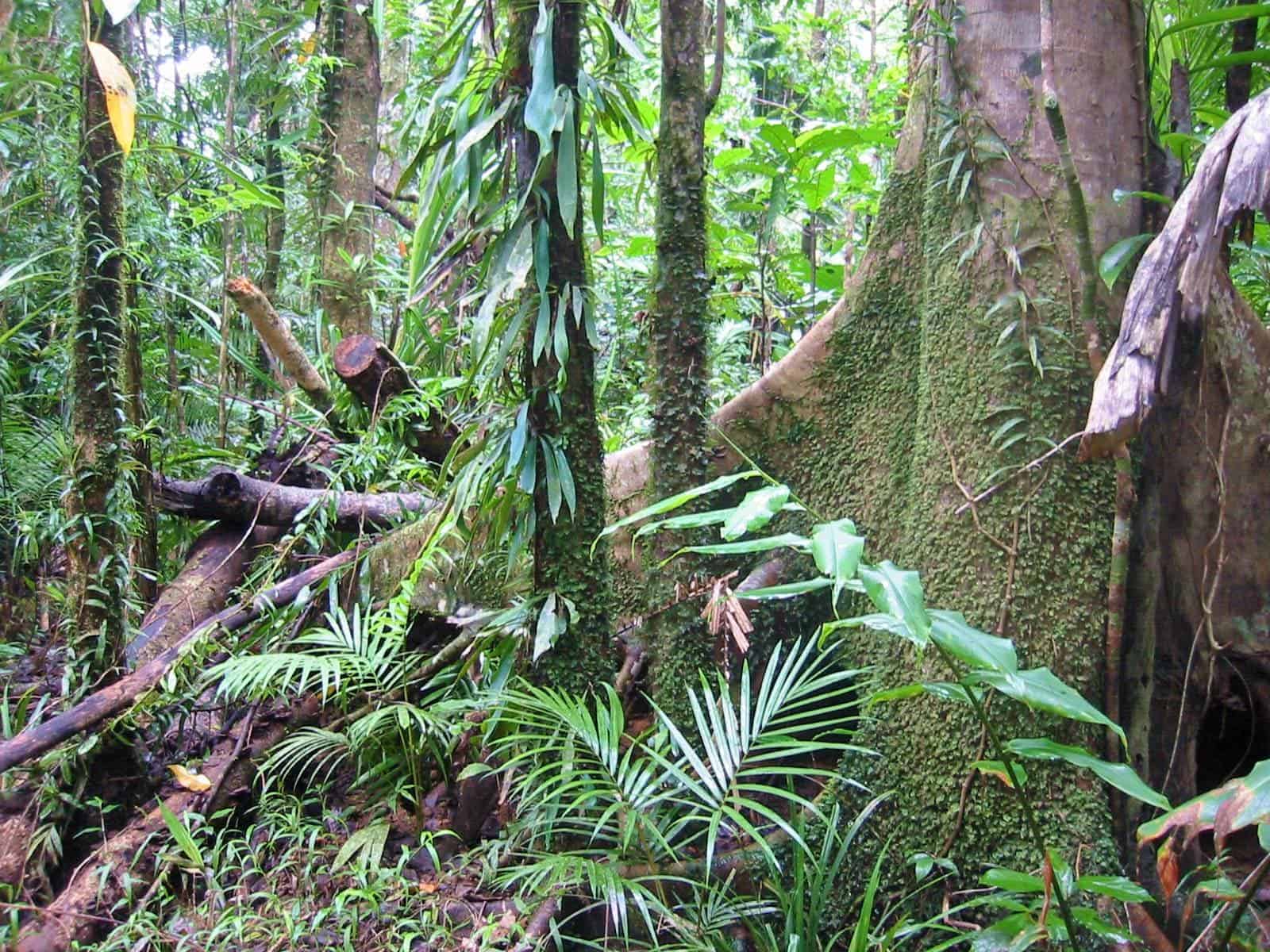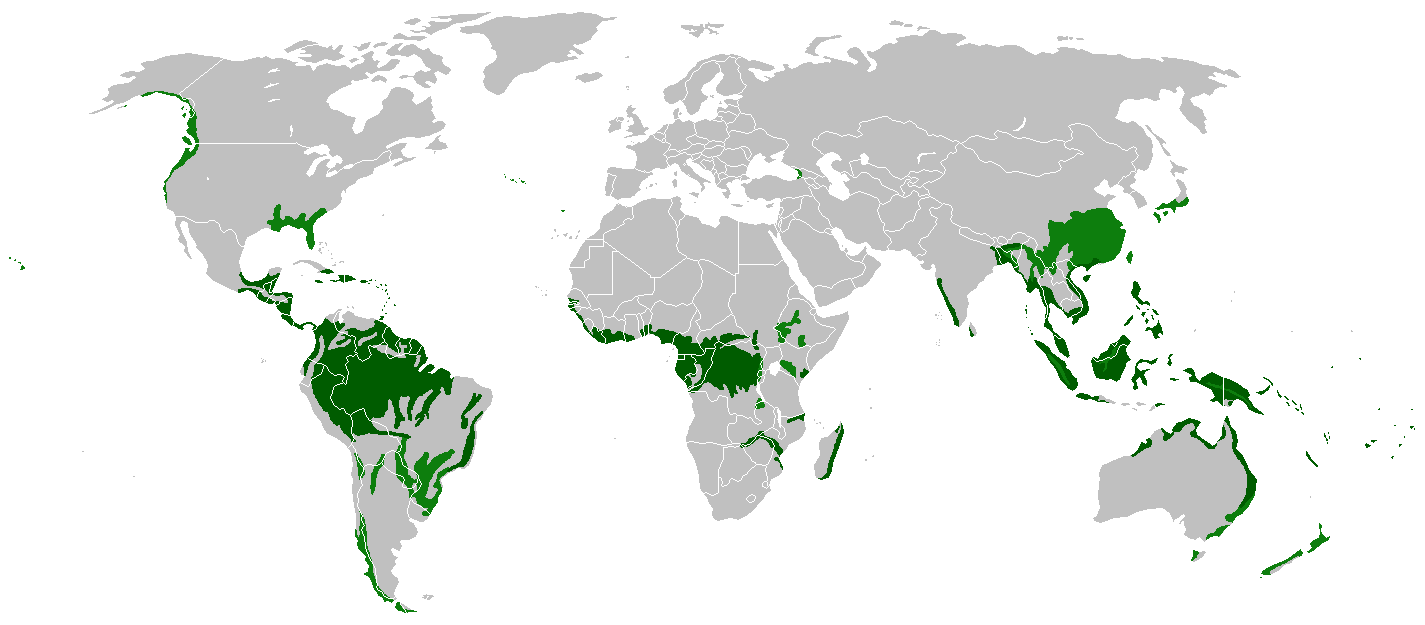TROPICAL FORESTS

TROPICAL FORESTS
Tropical rain forests grow around the equator in South America, Africa, and Southeast Asia. They have the highest species diversity per area in the world, containing millions of different species. Even though they cover only a small part of the earth, they house at least one half of all species. The temperature is stable year-round, around 27°C (60° Fahrenheit). As you can tell from the name, it rains a lot in these forests. Most tropical forests receive at least 200 cm (80 inches) of rain in a year. Tropical forests generally have a rainy and dry season.
The high temperatures, abundant rainfall, together with twelve hours of light a day promotes the growth of many different plants. One square kilometer (0.6 miles) can have up to 100 different tree species. Broadleaf trees, mosses, ferns, palms, and orchids all thrive in rain forests. The trees grow very densely together and the branches and leaves block most of the light from penetrating to the understory. Many animals adapted to life in trees — such as monkeys, snakes, frogs, lizards, and small mammals — are found in these forests. The soil can be several meters deep, but due to nutrient leaching, it lacks most of the essential nutrients for plant growth. The thin topsoil layer contains all the nutrients from decaying plants and animals, and this thin layer sustains the many plant species in the forest. One might think that the soil would be very rich because it supports so much life, but when tropical forests are clear-cut, the soil is useless for agriculture after only a few years — when the topsoil becomes depleted.
The soil can be several meters deep, but due to nutrient leaching, it lacks most of the essential nutrients for plant growth. The thin topsoil layer contains all the nutrients from decaying plants and animals, and this thin layer sustains the many plant species in the forest. One might think that the soil would be very rich because it supports so much life, but when tropical forests are clear-cut, the soil is useless for agriculture after only a few years — when the topsoil becomes depleted.
Different subcategories within tropical rain forests
- Evergreen: rain year-round, no dry season
- Seasonal: vegetation evergreen, short dry season,
- Dry: long dry season in which trees lose leaves
- Montane: most precipitation from mist or fog that rises (also called cloud forests), mostly conifers
- Tropical and subtropical coniferous: dry and warm climate with conifers adapted to variable weather
- Sub-tropical: north and south of tropical forests, trees adapted to resist summer drought
Tags
Comment / Reply From
You May Also Like
Popular Posts
Newsletter
Subscribe to our mailing list to get the new updates!
Categories
- Places and Regions (349)
- Health & Science (3559)
- Jobs (188)
- Work Life (286)
- Opinions (426)
- Real estate & Properties (121)
- Shipping & Logistics (64)
- Sex & Relationships (1755)
- Movies & Animation (6102)
- Comedy (229)
- Travel and Events (427)
- Gaming (1185)
- History and Facts (1296)
- People and Nations (1020)
- Science and Technology (3704)
- Arts & Entertainment (1810)
- Life Style (3627)
- Education (3386)
- Economics and Trade (1950)
- Others (5396)
- News and Politics (3218)
- Cars and Vehicles (430)
- Pets and Animals (326)
- Digital Marketing & Web Develpment (4)
- Robotics, VR & AR (0)
- DFTUntoldStories (1)
- Celebrities (83)
- Mobile Solutions & Apps (0)
- Ecommerce & Clean Tech (0)
- Artificial Inteligence & IoT (0)
- Big Data & Cyber Security (0)
- Business (1780)
- Palscity Show (0)
- Sports Show (0)
- Politics & Leadership Show (0)
- Digitally Fit Show (0)
- Entertainment & Lifestyle Show (0)
- Business Show (1)
- In The Morning Show (0)
- DFT Reels & Shorts (0)
- Natural & Food (1141)
- People and Culture (11)
- Sports (1906)
- Fashion (116)
- Gossip (55)
- Music (116)


